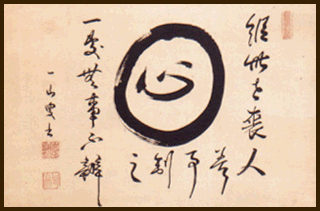 | |
| Enso by Isan Shinko (1740-1815) |
Sensei has said that the word happo suggests infinity. He said that placing the number eight on its side gives us that symbol ∞. Soke goes on to explain that a technique does not have a beginning or end but just flows one into the other like the symbol.
A simple way to consider this is with tai sabaki. In angling we often start with cardinal points for evasion or striking (please excuse my clumsy finger diagrams):
Then we split those four directions to make 8:
Then split again:
You can see how it begins to get infinite... especially if you add the up and down directions so any angle in space is possible leading to a sphere:
Or the Japanese Zen symbol of Enso:
Hatsumi Sensei says that kihon is like thrusting your sword into a point about which there is an Enso or limitless circle (happo) and existing in the space is the kukan.
If you want a clue to the study of that infinite space, you may read the calligraphy of the first Enso I posted at the top of this post by Isan Shinko. In the center is the character for heart, which you may recognize as part of our 忍 "nin" symbol. And the calligraphy says,
"Keep yourself firmly centered inside here and nothing will be able to shatter you. "If you subscribe to my training notes (if you aren't a subscriber yet, you miss a LOT of free Bujinkan notes), you can get even more of these ideas that Hatsumi Sensei shares during my classes with him.






Comments
Post a Comment